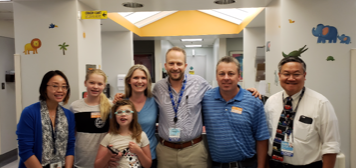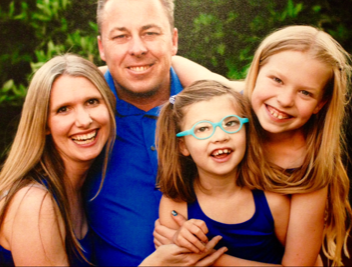LCA Families Finding Strength with Each Other
Heather Le’s anxiety accompanying her daughter’s diagnosis of Leber congenital amaurosis melted into relief when she connected with a mom whose daughter was also born with LCA. And this mom – Christina Reichardt – came with the bonus of being Doctor Mom. Christina Reichardt, the mother of LCA patient Ashlyn, is a doctor of optometry in Tucson, Ariz.
The two connected when Heather, of San Diego, Calif., learned from Christina that her daughter underwent a procedure at Children’s Hospital of Los Angeles (CHLA) to correct an LCA gene mutation. Heather’s daughter, Monroe, and Christina’s daughter, Ashlyn, have LCA with a mutation in their RPE65 gene.
Dr. Aaron Nigel administered the ground-breaking genetic therapy called LUXTURNA™ to Ashlyn last May and June when she was 10 years old. Two months later, 6-year-old Monroe had the same surgery, in which a human-engineered virus containing a healthy version of the gene is injected under each retina, a week apart.
Dr. Nigel asked Christina if she would connect with other families living with LCA-RPE65, a request she considered an honor.
“It’s has been the biggest blessing to connect,” Christina said. “I truly consider these moms as friends and know we will always have the special LUXTURNA connection.”
She said she talks to at least one RPE65 mom a week: “It’s a highlight, sharing experiences and stories and life. Checking in the days of surgery and the days thereafter.
“It’s good for both of us,” she said. “We need to heal, too, as parents.”
 Driving home from Ashlyn’s surgery, Christina talked with Heather, who was thrilled to get answers from the “mommy and doctor side.”
Driving home from Ashlyn’s surgery, Christina talked with Heather, who was thrilled to get answers from the “mommy and doctor side.”
“She walked me through everything. I don’t know what I would do without that woman,” Heather said. “I mean she has been absolutely amazing. Since I had Christina to reach out to, I was more at ease because she was there for me to ask any mother questions I had.”
Christina enjoyed sharing her experiences.
“We still keep up with one another. We share videos and photos. I shared pre-op and post-op experiences, how Ashlyn felt, medicine talk of how she felt and the best way I found to get her drops and ointment in her eyes.”
Heather and Christina are among the many people who have connected and helped each other in their journeys with LCA or other inherited retinal diseases (IRDs). Sharing stories, LCA families shed feelings of isolation that often accompany diagnoses of rare diseases, and they become part of an understanding and resourceful community.
Sofia Sees Hope encourages and helps make these kinds of connections through its Family Connections program, its Facebook page and events, including its upcoming second LCA Family Conference in Philadelphia from July 26-28.
Genetic diagnosis is key
To get a clinical diagnosis, Christina and Heather knew they would have to have their daughters genetically tested.
Even though Heather felt scared, she knew she needed that diagnosis to get more answers. Shortly after Monroe turned 4, she received her RPE65 genetic diagnosis. (See Monroe’s Jan. 1, 2019, story on our website.)
Christina knew three hours after giving birth that something was not quite right with her daughter. Ashlyn was misdiagnosed with night blindness and, being a mom with a medical specialty in vision, she knew she had to start figuring out exactly what was affecting her daughter’s vision.
“I insisted on genetic testing.* She was tested genetically prior to this for other things. Since she was an infant, I said, ‘let’s just genetically test for everything.’ In my heart I felt there’s something more. If we don’t have a diagnosis that’s correct, we won’t have the information to help her.”
Christina, who practices optometry with her dad, said she had heard of LCA, but didn’t know much about it.
“This journey with Ashlyn has made me a better doctor.”
She felt happy to have a diagnosis, shocked because it’s not a common disease and upbeat, saying: “Hey,  this is something we can do something about. This is it; this is what we’re going to do. We never looked back.”
this is something we can do something about. This is it; this is what we’re going to do. We never looked back.”
The RPE65 diagnosis marked the first of many firsts.
“A feeling of peace and fear, but with that fear a calmness, once I was able to connect to others in the same situation,” Christina said. “Diagnosis was huge. Ashlyn was diagnosed much older than many.
“I believe many kids are still not diagnosed. Getting the word out is going to be very important. That (genetic) test is what we all should consider … It was incredible timing because it was like, boom, we got the diagnosis in May of 2017, LUXTURNA was approved in December and she had her surgery in May 2018. The whole thing went from not moving at all to warp speed.”
Moms helping moms
Along the road to surgery, Christina received answers to her many questions from Beth Guardino of Patchogue, New York, mother of Christian, who underwent the same surgery during LUXTURNA’s 2013 clinical trials. (See Christian’s March 25, 2018, story on our website.)*
“I reached out to her,” Christina said after finding Beth’s story on Facebook. “She was to me who I was to Heather. I had a bazillion questions, so we were on the phone all the time. It’s so awesome … I just feel that all parents need that connection. It’s a scary thing to go through. There’s a lot of unknowns, and getting it from another mom is invaluable, the mom questions.
“From Beth talking to us before Ashlyn received LUXTURNA, to my conversations with several moms as their kids embarked on the same journey – it has been comforting to talk to another mom who has ‘been there, done that,’ to hear her son’s perspective, how she as a mom dealt, how much time and medicine was needed and just to talk about fear and feelings. She was a true blessing and made me more confident walking into such a big unknown.”
Four days after surgery, Christina’s family took a paddle boat ride. Ashlyn looked up at the sky and said, “Mom, what’s that?”
“It’s the sky, honey. That’s a cloud.”
“That’s a cloud?”
“Before she had no visual acuity to see fish or color in the tank,” Christina said. “She ran over to the tank. ‘I see the fish; I see a yellow fish and a pink fish.’ Things like that, that you don’t think about are huge for her.
“She didn’t realize that the toilet (water) swirls when you flush it. ‘Whoa. I thought it just made noise. It’s a swirl,’ her daughter realized.
“Now she walks so easily and runs. Now everything’s novel and exciting.”

